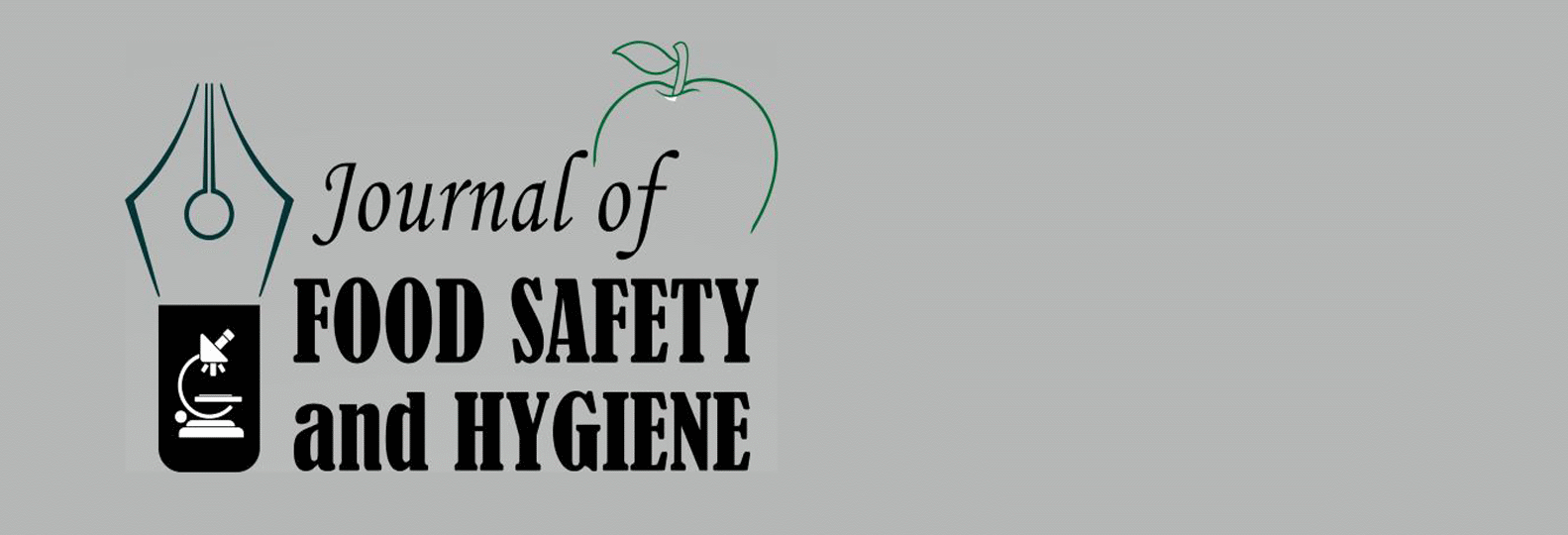

Journal of Food Safety and Hygiene (JFSH) is a peer-reviewed journal published quarterly and publishes Food Safety and Hygiene experiences in English Language. Journal of Food Safety and Hygiene aims to publish manuscripts of a high scientific quality representing original research papers. Short communication and high quality review papers on all aspects of the science of food safety and hygiene. Papers in English are welcomed, particularly those which bring novel information and research. All received manuscripts coving the scope of the journal will be evaluated by properly competent referees. The goal of this journal is to induce a research relation and to promote study, research and the improvement of knowledge among the specialists. The main topics the Journal would welcome are: Food safet, Food analysis and components, Cancer and food, Food packaging materials and concerns, Food preservation and processing, Cereals, fruits and vegetables in human health, Environmental contaminants in food, Natural toxins in food, Microbial food poisoning and infection, Food infestation, Food allergens and diseases, Climate change and food safety, Food spoilage issues, Food safety and bioterrorism, Animal nutrition and food safety, Food additives, Antioxidants and phytochemicals in food, Sanitation in food industry, Food safety and hygiene in hospitals, Safety and hygiene in food chain, Food safety and hygiene in disaster and emergency, Nutraceuticals (Food as Medicine and Health), Food and drug interactions, Bottled water safety.
Current Issue
Original Article(s)
-
This study evaluated the phytochemical, vitamin, microbial quality and sensory acceptability of functional drinks produced from blends of beetroot and ginger sweetened with date fruit syrup. Six blends were proportioned from juices of beetroot and ginger sweetened with date syrup and labeled as samples ICN (100:0), CHO (95:5), NGO (90:10), OJO (85:15), DMJ (80:20) and OJK (70:25) where sample ICN served as the control. The phytochemical, vitamin and microbial quality of the functional drinks were determined using standard analytical methods, while the sensorial evaluation was done by the 9-point hedonic scale. The results depicted that noticeable disparities (p<0.05) existed in the phytochemical and vitamin content of the functional drinks. The phytochemical content ranged from 0.1-0.38 mg/100 mL and 0.21 – 0.43 mg/100 mL for flavonoid and phenol respectively. The vitamin content results showed that vitamin A decreased, while vitamins B9 and C increased with rise in the proportion of ginger in the mixtures. The microbial results showed that the bacterial and fungal loads decreased significantly (p<0.05) with rise in the inclusion of ginger into beetroot. However, the bacterial and fungal loads of the functional drinks increased as the days of storage increased to 28 days. No coliform was detected in the drinks up to the 28th day of storage. The sensory results showed that sample NGO (90:10; beetroot: ginger) had the highest scores for appearance, aroma, taste, mouth feel and general acceptability. This study has shown that microbiologically safe functional drinks can be produced from blends of beetroot and ginger sweetened with date syrup.
-
The current study investigated the antioxidant and antimicrobial activities of ginger, saffron, and red pepper extracts. The extracts of plants were prepared by adding plant powder to distilled water and stirring at 60°C for 24 h. The antioxidant capacity was measured utilizing DPPH radical scavenging. The increasing order of antioxidant activity at 1 mg/mL concentration was as follows: saffron (78.5%) < ginger (79.3%) < red pepper (83.4%) < ascorbic acid (99.7%, as control). The TPC for ginger, red pepper, and saffron was 9.78 ± 1.42, 4.72 ± 0.85, and 6.41 ± 0.63 mg GAE/g, respectively. The TFC for ginger, red pepper, and saffron was 3.74 ± 0.65, 8.78 ± 0.42, and 2.61 ± 0.34 mg QE/g, respectively. The antimicrobial activities of plant extracts were assessed using the minimum inhibitory concentration (MIC) and minimum bactericidal concentration (MBC). The saffron extract had the highest inhibitory effect against Bacillus cereus (MIC = 3.12 mg/mL, MBC = 6.25 mg/mL) and Staphylococcus aureus (MIC = 6.25 mg/mL, MBC = 12.5 mg/mL). Ginger extract also showed high efficacy, especially against S. aureus (MIC = 3.12 mg/mL). In contrast, red pepper extract had a less potent effect on the studied species. The findings of this study showed that plant extracts had suitable antioxidant and antimicrobial properties, making them a good choice for use as natural preservatives in various industries.
Review Article(s)
-
The Giant African Land Snail (GALS), which is the biggest known land snail in the world, has been a delicacy in West and Central Africa for several centuries. This study used literature to assess the proximate composition, nutritional and health benefits, and potential health hazard connected with the consumption of the three commonest GALS species; Archachatina marginata, Achatina fulica (recently renamed as Lissachatina fulica) and Achatina achatina. The study found that the meat from the snail is highly nutritious on account of the high protein, mineral and vitamin content but low fats and cholesterol. Meat and other products from the snail are used in traditional African folklore medicine for the management of some disease situations such as anaemia, obesity, diabetes, hypertension, arthritis among others. In addition, by-products from the snail such as shell has potential application as calcium supplements, while the mucus has antimicrobial properties and has been used in cosmetics and for reconstructive surgery. But the consumption of the snail is challenged by the presence of pathogens and parasites, which can potentially cause food-borne diseases and other health problems, which occur mostly among people that consume raw or improperly cooked snail meat. We conclude that the risk of snail meat consumption can be substantially minimized through pre-processing of cultured snails followed by adequate cooking.

